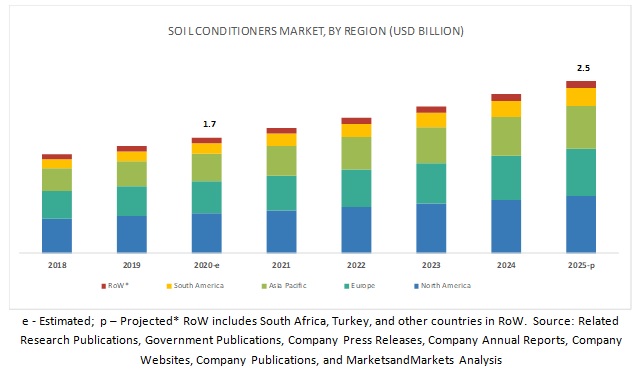The report “Soil Conditioners Market by Type (Surfactants, Gypsum, Super Absorbent Polymers, and Others), Application (Agriculture, Construction & Mining, and Others), Formulation (Liquid and Dry), Crop Type, Soil Type, and Region – Global Forecast to 2025″ The global soil conditioners market is estimated to account for a value of USD 1.7 billion in 2020 and is projected to grow at a CAGR of 8.3% from 2020, to reach a value of USD 2.5 billion by 2025. Increased demand for agricultural crops such as rice, wheat, and soybean, especially from the developing countries and decrease in availability of agricultural land owing to urbanization is among the key factors expected to drive the soil conditioners market.

Report Objectives:
- To define, segment, and project the global market size for the soil conditioners market
- To understand the structure of the market for soil conditioners by identifying its various subsegments
- To provide detailed information about the key factors influencing the growth of the market (drivers, restraints, opportunities, and industry-specific challenges)
- To analyze the micro-markets, with respect to individual growth trends, prospects, and their contribution to the total soil conditioners market
- To project the size of the market and its submarkets, in terms of value, with respect to the regions (along with their respective key countries)
- To profile the key players and comprehensively analyze their core competencies
Download PDF Brochure: https://www.marketsandmarkets.com/pdfdownloadNew.asp?id=171774013
By formulation, the liquid segment is projected to grow at the highest CAGR in the soil conditioners market during the forecast period.
The liquid forms are applied on a volume basis rather than a weight basis. The liquid form provides various options for crop growers to mix soil conditioners with insecticides, fungicides, or adjuvants. Compared to the dry form, little quantity of liquid soil conditioners is enough to cover larger crop areas, making it a preferable choice among farmers. In South America, the demand for liquid soil conditioners is expected to increase in the years to come, as they are easy to apply, do not require much labor, and increase yield.
By crop type, the cereals & grains segment is projected to dominate the global soil conditioners market during the forecast period.
Cereals & grains are the staple food products in many countries, which include wheat, rice, corn, sorghum, oats, and barley. With the increase in population and food demand, the basic requirement of farmers is to increase the yield of cereals & grains in a sustainable way. Here, the demand for soil conditioners, such as surfactants (soil wetting agents), gypsum, and natural polysaccharide derivatives, is expected to improve the quality and quantity of cereals & grain crops.
Make an Inquiry: https://www.marketsandmarkets.com/Enquiry_Before_BuyingNew.asp?id=171774013
North America accounted for the largest share during the forecast period.
The North American region accounted for the largest share during the forecast period. The increase in industrial activities is a key factor that has caused soil degradation in the North American region. Also, North America hosts several mining activities, which lead to barren soil that is susceptible to erosion by wind and rain. . In North America, contamination of the surface in farms and mining to extract minerals, coal, oil, or gas has resulted in soil degradation. According to a report published by Cornell study 2017, in the US, soil disappears ten times faster than it is naturally replenished at an estimated rate of nearly 1.7 billion tons of farmland per year. These factors have contributed to rise in demand for soil conditioners in the region.
This report includes a study on the marketing and development strategies, along with a study on the product portfolios of the leading companies operating in the soil conditioners market. It includes the profiles of leading companies, such as BASF (Germany), Syngenta (Switzerland), Novozymes (Denmark), Solvay (Belgium), UPL (India), Clariant (Switzerland), Evonik Industries (Germany), Eastman Chemical Company (US), Croda International PLC (UK), ADEKA Corporation (Japan), Vantage Specialty Chemicals (US), Aquatrols (US), Rallis India Limited (India), Humintech GmbH (Germany), GreenBest Ltd (UK), Omnia Specialities Australia (Australia), Grow More, Inc. (US), Geoponics Corp. (US), Delbon (France), and FoxFarm Soil & Fertilzer Co. (US).

